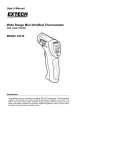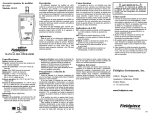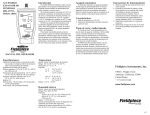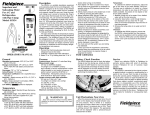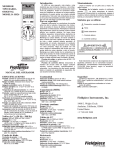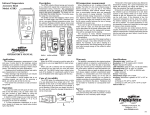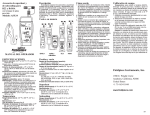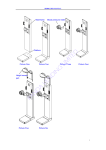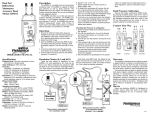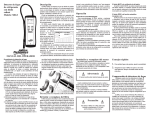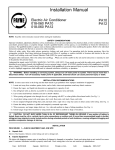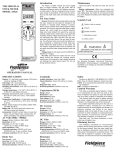Download Opman ASX14 v07.qxd - Fieldpiece Instruments
Transcript
Superheat and Subcooling Head for R22 and R410A Description The model ASX14 superheat and subcooling accessory head measures refrigerant pressure and temperature simultaneously. It then calculates and displays superheat or subcooling. It has a 1/4” industry standard fitting for actual pressure. A pipe clamp thermocouple is included for temperature. Select R22 or R410A. Select superheat or subcooling.Select english or metric units. with pipe clamp thermocouple Model: ASX14 Use it your way STABLE Air Conditioner Superheat and Subcooling ON LO BATT R22 SH ENGLISH R410A SC METRIC STABLE STABLE Air Conditioner Superheat and Subcooling R22 R410A STABLE STABLE Air Conditioner Superheat and Subcooling SH or SC Temp Pressure ON LO BATT R22 SH ENGLISH R410A SC METRIC Air Conditioner Superheat and Subcooling Air Conditioner Superheat and Subcooling ON LO BATT SC R22 SH ENGLISH R410A SC METRIC ENGLISH METRIC ON LO BATT R22 SH ENGLISH R410A SC METRIC SH or SC Temp Pressure SH or SC Temp Pressure Set ATM SH or SC Temp Pressure SH or SC Temp Pressure ON LO BATT SH T/C Cal Set ATM T/C Cal AUTOOFF AUTOOFF ASX14 ASX14 Set ATM Set ATM T/C Cal AUTOOFF T/C Cal AUTOOFF Set ATM T/C Cal AUTOOFF ASX14 ASX14 ASX14 OFF 2000 OPERATOR’S MANUAL SPECIFICATIONS Operating environment: 32ºF to 122ºF; 0ºC to 50ºC at <75%RH Allow ~5 min. for ASX14 to come to ambient temp. Storage environment: -4ºF to 140ºF; -20ºC to 60ºC at <80%RH with battery removed. Battery life: 25 hours typical. No measurable current draw when in "off" position. Low battery indication: Red LED lights Battery: 9V Auto off: Approx. 15 minutes Overloads: The ASX14 outputs 3.4V when temperature or pressure is outside of their working range (overloaded). For ranges below 3400mVDC, the normal overload symbol will be displayed on the meter (“OL”). For ranges above 3400mVDC, reading displayed will be approximately 3.4VDC. Stated Accuracy: at 73°F ± 9°F (23°C ±5°C) , <90% R.H. Temperature Range (temperature): -40ºF to 400ºF; -40ºC to 204ºC Resolutions: 0.1º Sensor type: k-type thermocouple Pipe clamp thermocouple accuracy: ±4ºF (±2°C) or ±0.75%, whichever is greater, -30ºF to 200ºF (-34°C to 93°C) System accuracy: ±1ºF;±0.06ºC @ 73ºF ± 5ºF EHDL1 AHDL1 w/ Meter DL3 HS30 after ice water calibration (see Field calibration). Pressure and vacuum Working range (pressure): 0 to 500 psi; 0 to 4000 kPa Max displayed pressure: 800psi (5500 kPa) Working range (vacuum): 29”Hg vac. to 0; 74cmHg vac. to 0 Vacuum will show up as negative value on meter. Resolutions: 0.1psi or kPa, 0.1”Hg or cmHg vac. Accuracy: 0 to 200 psig, ±1 psi, 0 to 1378 kPa ±6.9 kPa; 200 to 500 psig, 0.3% ±1 psi, 1378 to 3447 kPa 0.3% ±6.9kPa Sensor breakdown pressure: 800psi (5500 kPa) Superheat Range (temperature): 0ºF to 80ºF; 0ºC to 27ºC Resolutions: 0.1º System Accuracy: ±1ºF @ 73ºF ± 5ºF (±0.06ºC @ 23°C ±3°C) after calibration (see Field calibration). How to use 1. Connect to COM and Volts jack. Slide ASX14 superheat head onto Fieldpiece "stick" meter, data logger, electronic handle or connect to most other meters using Fieldpiece ADLS2 deluxe test leads or AHDL1 handle. 2. Set meter to mVDC range. 3. Calibrate if needed (see Field calibration) 4. Hand tighten 1/4” flare to suction line or liquid line as close to the evaporator or condenser as possible using an EPA approved service hose (not included). 5. Select superheat or subcooling, refrigerant (R22 or R410A) and units (English or metric). 6. Connect the pipe clamp to the suction (superheat) or liquid (subcooling) line at least six inches from the condenser and slide it under the insulation for best accuracy isolating the pipe clamp from the ambient air (pg. 2). 7. Select parameter to display (superheat, subcooling, pressure, or temperature). 8. You must wait until the system you are testing has stabilized. The STABLE LED lights when the reading is stable. 9. Disable Auto-off to data log any of the above parameters with the DL3 data logger. 10. Once you have the superheat or subcooling reading follow the manufacturer of the air conditioner’s specifications to properly charge or diagnose the system. Field calibration Temperature: To calibrate the system (ASX14, pipe clamp thermocouple, meter), adjust the calibration pot underneath the rubber covering while measuring a known temperature. Ice water is 32°F (0°C) and is readily available. 1. Stabilize (by repeated stirring) a large cup of ice water. 2. Select temperature on ASX14, plug in the pipe clamp thermocouple and then immerse entire clamp into the ice water (keep stirring). 3. Adjust the calibration pot to read 32.0 (0.0 if using °C) on the DMM for optimum accuracy at room temp. Pressure: The pressure/vacuum reading prior to connecting to an A/C system should always be zero. If you see that you’re getting pressure readings of something other than zero without your service hose attached, you need to set atmospheric pressure before connecting the ASX14 to the system. To set atmospheric pressure, press the button underneath the rubber covering entitled “Set ATM”. You usually have to set atmospheric pressure each time you dramatically change elevations. For example, if you “Set ATM” in Denver and take a pressure reading of an A/C system in Los Angeles, the pressure reading in Los Angeles will be lower than it actually is. Warranty The ASX14, Superheat and Subcooling accessory head is warranted against manufacturer’s defects for one year. This warranty does not apply to defects resulting from abuse, neglect, accident, unauthorized repair, alteration, or unreasonable use of the instrument. Any implied warranty arising out of the sale of Fieldpiece's products including but not limited to implied warranties of merchantability, and fitness for purpose, are limited to the above. Fieldpiece shall not be liable for incidental or consequential damages. . Service Return any defective ASX14 to Fieldpiece for warranty service along with proof of purchase. Contact Fieldpiece for out of warranty repair charges. Subcooling Range (temperature): 0ºF to 80ºF; 0ºC to 27ºC Resolutions: 0.1º System Accuracy: ±1ºF @ 73ºF ± 5ºF (±0.06ºC @ 23°C ±3°C) after calibration (see Field calibration). v07 head for both indoor wet bulb and outdoor dry bulb. Or you can use any Fieldpiece meter that has a temperature function along with a ATWB1 wet bulb thermocouple. Below is a diagram of the ASX14 on a split-system residential A/C unit. Checking Subcooling Using the ASX14 In do o r Throttle Valve (TXV, Cap tube, Fixed Oriffice) STABLE Air Conditioner Superheat and Subcooling ON LO BATT R22 SH R410A SC ENGLISH METRIC Fl Liquid igerant Condenser ow Fl Vapor and Liquid igerant Liquid ASX14 Evaporator Re fr AUTOOFF ut si T/C Cal O Set ATM de SH or SC Temp Pressure Re fr Vapor and Liquid Vapor In do o r Vapor ut si Heed all equipment manufacturer’s specifications, warnings and suggestions above anything found in this manual. To determine the target superheat (fixed orifice system) or subcooling (charts vary dramatically from one system to another), you will typically need three things. Outdoor dry bulb (outdoor air temperature), indoor wet bulb, and the manufacturers target superheat chart or subcooling chart. You can use the ARH4 Fieldpiece accessory de Target superheat and subcooling O Superheat is the difference between the actual temperature of the refrigerant (gas) as it leaves the evaporator and the boiling point temperature of the refrigerant in the evaporator coil. After boiling, the refrigerant continues to warm up. The number of degrees it “warmed up” after boiling is called the superheat. Under worst case conditions (low load for fixed orifice systems), the refrigerant in the evaporator boils off near the end of the evaporator coil. To make sure liquid doesn’t enter the compressor under the worst case condition (low load), the AC manufacturers publish charts indicating what the superheat should be at a given indoor wet bulb measurement and outdoor air temperature. Measuring superheat is your best indication on a fixed orifice system of the proper refrigerant charge and operating conditions. If everything else is working properly and the actual superheat is too high, add refrigerant. If it’s too low, remove refrigerant. Subcooling is the difference between the boiling point of the refrigerant in the condenser and the actual temperature of the refrigerant as it leaves the condenser. The degrees that the refrigerant “cools down” below the boiling point is the subcooling. Under worst case scenario (low load for TXV) the subcooling will continue to rise. If the subcooling rises to high, liquid may be backed into the compressor causing damage and catastrophic failure. On TXV systems, subcooling is the best indication of the state of charge in the refrigerant system since these systems are designed to maintain constant superheat. Properly charging a system ensures maximum efficiency and longer equipment life. The hose must have a schraeder valve depresser on one end to release the refrigerant from the suction or liquid line. This is the same type of hose available with most pressure gauge sets. We suggest EPA sanctioned “no leak” hoses. Exercise caution whenever working with any electricity and high pressure liquid or gas. Follow all instructions provided with equipment being serviced or installed. ow Measuring actual superheat and subcooling Compressor STABLE Air Conditioner Superheat and Subcooling ON LO BATT R22 SH R410A SC ENGLISH METRIC SH or SC Temp Pressure Set ATM T/C Cal Checking Superheat Using the ASX14 AUTOOFF ASX14 Generic Target Superheat Charts* * These charts are an example of a generic superheat charts for a typical fixed orifice, split residential system. These charts should not be used for charging. A typical manufacturer’s recommended subcooling is 12°F (7°C). These are only examples of what the manufacturer’s may recommend. Heed all manufacturer’s indications, instructions and warnings above those in this manual. The indoor wet bulb measurement can be accomplished by a Fieldpiece ARH4 or ATWB1 and should be taken as close to the evaporator coil inlet as possible. The outdoor dry bulb reading can be taken with an ARH4, ATB1, ATA1 or any other Fieldpiece air thermocouple and should be taken as close to the condenser air inlet as possible.


